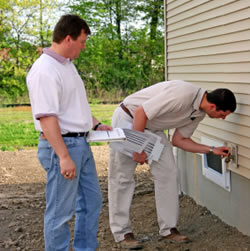December Home Maintenance
Congratulations on completing a year of home maintenance!
For many of us, December is a month for celebrations, family gatherings and
vacations. But if you find yourself prowling the house, feeling the need to do
something useful, we have a holiday wish list for your home.
When the first major snowfall of the year hits — and it's
likely to be this month if you live in North of the 401 — take advantage of the
event to learn things about your house that only snow can show. Is the snow
melting from your roof rapidly? That means heat is escaping from your home
through the roof and you should consider adding some attic insulation. Rapid formation
of icicles without a thaw is another indication that you're losing heat through
the roof.
If you find that you are losing a lot of heat through your
roof, take a look at the insulation in your attic floor. It should be uniformly
thick and distributed evenly with no gaps. The vapor barrier side should be
facing downward — toward the living space you are trying to keep warm. Also,
the insulation should be dry.
Is your home properly
insulated?
There are many chores that need doing after a big snow;
consider the tasks as your excuse to get outside and enjoy winter.
Clear walkways with a snow shovel and sprinkle sand or salt
on them for traction. (Be careful with the salt, though — it can leach into
flower beds and is hard on pets' feet.)
Check your roof for ice dams and break them up to release
water if necessary.
Frozen dams along the eaves cause melted snow to puddle
above and possibly leak through the roof.
Knock snow from tree branches to keep them from breaking
under the weight.
Consider sweeping snow from roofs that have shallow angles
or little support (sheds, carports, lean-tos) if it can be done safely.
Professional Services
Find local plumbers, electricians, contractors and more.
As a temporary measure to get through a cold winter with
pipes intact, block north-facing crawl-space vents with a piece of plywood.
If an unusual cold snap is predicted and you live in an
older, not-so-well-insulated house, leave the sink and bathtub faucets on at a
slow trickle to keep pipes from freezing. This is especially important if the
heat is turned off in the house for any period; for example, during the day
when the house is empty.
If you have oil heat, you can save fuel and repair costs by
cleaning some parts of the oil burner yourself. Turn off power to the system,
lift the blower cover and then dust the blades of the blower. Lubricate the
motor by pouring oil in the oil cups. If you're ambitious, you can even clean
the oil strainer and replace the filter. Check the owner's manual to get
details on do-it-yourself maintenance for your oil burner.
Winterizing Your Home
If you have forced-air heating ducts, check ducts once a
year for leaks and seal with (yes) duct tape. Routinely vacuum dust from duct
grilles, and have the entire system professionally cleaned annually, or as
recommended by your heating system's maintenance manual.

If mice have invaded your home despite efforts to keep them
out, don't be soft-hearted. They can do damage that ranges from leaving a mess
of droppings to chewing your home's wires, which can burn your house down.
First, discern whether you have rats or mice: Rats make a lot of noise and
leave half-inch droppings. Next, buy a dozen appropriately sized traps, bait
half of them (peanut butter works well and is cheap) and place them without
setting them. After the rodents have taken the first bait, rebait and set all
the traps in one fell swoop. Wear gloves to dispose of the rodents, trap and
all. (Do not try to reuse traps or you'll have a harder time going through with
the chore.) Mice and rats breed like ... well, rabbits, so keep repeating this
cycle until you see no new evidence of these unwelcome, hazardous houseguests.

Take time to evaluate your home's emergency kit. A
battery-powered radio, a first-aid kit, blankets, several gallons of fresh
water, tools for shutting off gas and water lines, candles and matches,
flashlights and batteries should all be included. Check the batteries — they
can drain with time, even if not used. If you live in an area with extremely
cold winters, make sure you have a backup heat supply, whether it's a wood
stove and a well-stocked woodshed, or a backup generator.
Winter is the perfect
time of year to itemize what changes you'd like to make in your house … because
you're cooped up in it!
Take a day to sit and make a list of what you'd like
changed, from new throw rugs to a complete remodel. If a remodeling job is on
your list and you want to begin as soon as the weather warms, start talking to
contractors this month. If you just bought a home, live in it for a full year
before you undertake a major remodel. Become intimate with your house; watch
how it interacts with its environment through spring, summer, fall and winter.
This will help you decide what you truly need — and keep you from putting a
sunroom in a spot that gets sun only two months out of the year.
 It's best to avoid placing statues or figurines on your home's roof. High winds, driving sleet or heavy snow can rip the figures from their foundations and damage yours and nearby homes or injure neighbors.
It's best to avoid placing statues or figurines on your home's roof. High winds, driving sleet or heavy snow can rip the figures from their foundations and damage yours and nearby homes or injure neighbors.
















